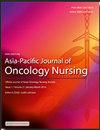恶性淋巴瘤间歇化疗患者的家庭症状管理:一项使用网络分析的前瞻性观察研究
IF 2.4
3区 医学
Q1 NURSING
引用次数: 0
摘要
目的探讨恶性淋巴瘤患者间歇化疗期间的家庭症状负担,并利用网络分析方法识别核心症状。方法采用前瞻性观察性研究,于2019年12月至2020年12月招募208例患者。在第一至第三个化疗周期(T1-T3)的三个时间点,使用MD安德森症状量表-中文版(MDASI-C)评估症状负担。在每个时间点构建症状网络,分析中心性指数,识别核心症状和桥梁症状。网络比较测试(NCT)用于检查症状互联性随时间的变化。结果共纳入受试者208人。疲劳和呕吐分别是所有时间点报告的最普遍和最严重的症状。在所呈现的症状网络中,食欲不振(rs = 1.13)、悲伤(rs = 1.20)和恶心(rs = 1.13)分别是T1、T2和T3的核心症状。在T1、T2和T3时,食欲不振(rb = 21, rc = 0.01)、焦虑(rb = 25, rc = 0.01)和口干(rb = 11, rc = 0.01)分别被确定为桥状症状。NCT结果显示,三个时间点的整体症状网络强度和总边缘权重无统计学差异,而悲伤在T2网络中表现出更高的中间性和紧密性(T1 vs. T2, Pc = 0.03, Pb = 0.03;T2 vs T3, Pc = 0.01, Pb = 0.03)结论食欲不振、悲伤和恶心是恶性淋巴瘤间歇化疗患者症状管理的关键指标。护理人员和医疗保健提供者应关注这些症状,以改善以家庭为基础的症状管理,提高患者的幸福感。本文章由计算机程序翻译,如有差异,请以英文原文为准。
Home-based symptom management for patients with malignant lymphoma undergoing intermittent chemotherapy: A prospective observational study using network analysis
Objective
This study aimed to explore the symptom burden of patients with malignant lymphoma at home during the intermittent periods of chemotherapy and identify core symptoms using network analysis.
Methods
A prospective observational study was conducted, recruiting 208 patients from December 2019 to December 2020. Symptom burden was assessed using the MD Anderson Symptom Inventory-Chinese version (MDASI-C) at three time points during the first to third chemotherapy cycles (T1–T3). Symptom networks were constructed for each time point, and centrality indices were analyzed to identify core and bridge symptoms. Network comparison tests (NCT) were used to examine changes in symptom interconnectivity over time.
Results
A total of 208 participants were included in the data analysis. Fatigue and vomiting were the most prevalent and severe symptoms reported at all time points, respectively. In the presented symptom network, lack of appetite (rs = 1.13), sadness (rs = 1.20), and nausea (rs = 1.13) were the core symptoms of T1, T2, and T3, respectively. Lack of appetite (rb = 21, rc = 0.01), distress (rb = 25, rc = 0.01), and dry mouth (rb = 11, rc = 0.01) were identified as bridge symptoms at T1, T2, and T3, respectively. NCT results indicated no statistical differences in the global symptom network strength and overall edge weight among the three time points, while sadness exhibited higher betweenness and closeness in the network of T2 (T1 vs. T2, Pc = 0.03, Pb = 0.03; T2 vs. T3, Pc = 0.01, Pb = 0.03)
Conclusions
The findings highlight lack of appetite, sadness, and nausea as critical targets for symptom management in patients with malignant lymphoma undergoing intermittent chemotherapy. Caregivers and healthcare providers should focus on these symptoms to improve home-based symptom management and enhance patient well-being.
求助全文
通过发布文献求助,成功后即可免费获取论文全文。
去求助
来源期刊

Asia-Pacific Journal of Oncology Nursing
Multiple-
CiteScore
2.80
自引率
11.10%
发文量
136
审稿时长
31 days
 求助内容:
求助内容: 应助结果提醒方式:
应助结果提醒方式:


